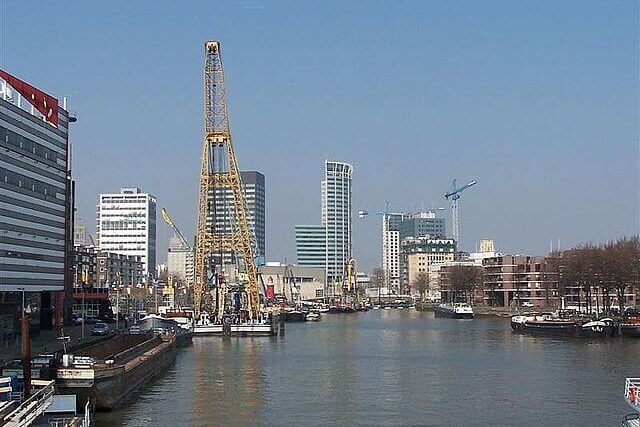
Navigating through the turbulent waters connecting Rotterdam’s industrial port zones to its historic maritime glory, the roar of a powerful diesel engine reverberates from a water taxi.
Approaching the elegant Hotel New York, a relic of Dutch shipping history, the building once housed the headquarters of Holland America Line, surviving the extensive WWII bombing that razed much of Rotterdam.
Amidst this maritime backdrop, the Port of Rotterdam Authority, stationed in a lighthouse-resembling skyscraper, shifts its focus from the city’s shipping legacy to shaping the future.
Collaborating with Singapore, it envisions and actively constructs one of the world’s pioneering long-distance green shipping corridors, heralding a transformative shift in the industry.
These green corridors propose cargo ships traversing routes exclusively fuelled by zero or low emission alternatives.
Rotterdam and Singapore, as architects of this visionary initiative, invest in infrastructure for storing green fuels like ammonia and methanol, aiming to replace conventional fuel oils. Green ammonia, produced by combining hydrogen with nitrogen using renewable energy, and methanol, a form of alcohol synthesizable with green energy, emerge as potential game-changers.
Boudewijn Siemons, the Port of Rotterdam’s interim chief executive, emphasises the practical application of this concept, exemplified by the inaugural journey of the Laura Maersk, a container ship powered by methanol.
“It’s a pragmatic approach to carbon reduction in shipping,” he says. “We have to get started somewhere, and you cannot get started by implementing zero emission shipping as a total solution everywhere in the world.
“That’s why we’re seeking these green corridors as proof points on a limited scale. We then have to scale up from there.”
The result: up to a 65% reduction in greenhouse gas emissions compared to traditional fuels.
The genesis of green corridors traces back to COP26’s Clydebank Declaration in 2021, where 22 nations, including the UK, committed to establishing at least six such corridors by the mid-2020s.
COP28 in the UAE witnessed the announcement of additional corridors, spanning Canada to Korea and Japan, the Caribbean, and Houston to Antwerp. These endeavours align with the International Maritime Organisation’s commitment for the shipping sector to achieve net-zero emissions “by or around” 2050.
While ports like Rotterdam gear up for the shift, shipbuilders face a monumental challenge. Current data reveals that merely 0.6% of global cargo ships run on alternative fuels, with only 15 to 16% of vessels on order opting for dual or alternative fuels.
Yet, there’s a discernible demand for green shipping, notably from industry giants like Amazon, committed to reduced emissions contracts with shipping leaders such as Maersk.
Noteworthy initiatives, like the launch of ammonia-powered ships by North Sea Container Line and Hoegh Autoliners building ammonia-ready vessels, underscore a growing momentum toward sustainable shipping.
Lynn Loo, CEO of the Global Centre for Maritime Decarbonisation, envisions a potential doubling or tripling of ammonia production by 2050.
Ms Loo says there needs to be “a dramatic rise in the number of vessels capable of transporting ammonia from the 200 that are on the water today”. She adds that there also needs to be “significant infrastructure buildout to support the much higher throughput of ammonia in the future”.
“None of these are going to be easy to scale,” observes Edward Glossop, head of sustainable operations at Bunker Holding, the world’s largest supplier of marine fuels.
“But ammonia may be the least challenging. The first ammonia engines will be delivered to shipyards by the end of 2024, and we aim to be a commercial supplier of low emission ammonia within the next few years.”
Despite this progress, the lack of enforced green shipping lanes raises questions about their widespread adoption.
“We know the future fuels will be expensive,” says veteran maritime economist Martin Stopford. “You’re attempting to implement change that’ll make people poorer, so it’ll be unpopular.”
Skeptics argue that even if clean fuel production scales up, competition with other sectors—manufacturing, domestic heating, road transportation, aviation—for limited supplies poses a formidable challenge.
“There is going to be some very big heavyweights in the queue ahead of shipping,” says Mr Stopford.
Mr Siemons acknowledges that the process of decarbonising shipping “is both complex and expensive”.
“But we should not predict the future based on the state of the technologies today, and on the state of the markets today,” he reasons.
“Yes today fuel oil is cheaper than hydrogen or ammonia, but that doesn’t mean it has to be so in the future.”
In Rotterdam’s waters, symbolic of maritime transition, yellow water taxis echo the shift. As early as 2016, Europe’s first electric-powered water taxi sailed these waters, joined last year by a hydrogen-powered counterpart, affirming the city’s commitment to a green maritime future.
“It all has to become renewable,” Mr Siemons concludes.
——————————————————————————
At Natural World Fund, we are passionate about stopping the decline in our wildlife.
The decline in our wildlife is shocking and frightening. Without much more support, many of the animals we know and love will continue in their decline towards extinction.
When you help to restore a patch of degraded land through rewilding to forests, meadows, or wetlands, you have a massive impact on the biodiversity at a local level. You give animals a home and food that they otherwise would not have had, and it has a positive snowball effect on the food chain.
We are convinced that this is much better for the UK than growing lots of fast-growing coniferous trees, solely to remove carbon, that don’t actually help our animals to thrive.
This is why we stand for restoring nature in the UK through responsible rewilding. For us, it is the right thing to do. Let’s do what’s right for nature!
Donate today at https://naturalworldfund.com/ and join in the solution!

